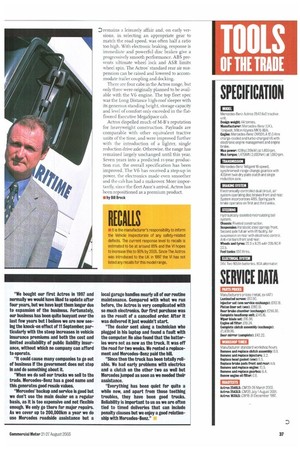n 1996, Mercedes-Benz replaced its venerable but dated SK range
Page 35

Page 37

If you've noticed an error in this article please click here to report it so we can fix it.
of heavy trucks with the Actros. The UK saw RHD versions arrive the following spring and, as well as bigger cab, it sported a plethora of electronics. It was a brave move as most operators were, at the very least, sceptical of the increasing amount of electrics that were being developed for new trucks at that time. The Actros had more than most, controlling the engine, gearbox, brakes and suspension. Technically, it was undeniably ahead of its time.
The earlier Powerliner's V8 engine, rated as high as 50311p, was carried over. But it was the smaller, lighter and more compact i2.o-litre V6 that was aimed at the fleet operator, with a choice of four outputs at 313hp for 36-tonne operation, 354hp for 38 tonnes, 394hp at 38 to 41 tonnes and 428hp for those looking for 44 tonnes.
Designed for a working life of a million kilometres, like the larger V8, each cylinder
has a capacity of 2.0 litres, individual heads with four valves per cylinder plus unit injecg tors to produce maximum power at r,goorpm and peak torque at Lo8orpm—where engine speed coincides with the lowest point on its specific fuel curve. It also includes an engine brake as standard. Telligent electronic engine management controls fuel injection, power delivery, cruise control and the speed limiter E while also monitoring on-board maintenance. E On-board diagnostics and the use of synthetic oil increase increase service intervals up to 12 o,00cktn, radically cutting back service costs. All maintenance and levels data are displayed inside the cab on an data panel.
Telligent manual is the standard 'EPS' electronic gear change system which incorporates a preselect for the r6-speed range change splitter transmission. While an electronic hand control is used to select each gear, the clutch pedal has to be depressed to activate the shift. Although this was an improvement on the earlier BPS system, gear changing remains a leisurely affair and, on early versions, in selecting an appropriate gear to match the road speed, was often half a ratio too high. With electronic braking, response is immediate and powerful disc brakes give a progressively smooth performance. ABS prevents ultimate wheel lock and ASR limits wheel spin. The Actros' standard rear air suspension can be raised and lowered to accommodate trailer coupling and docking.
There are four cabs in the Actros range, but only three were originally planned to be available with the V6 engine. The top fleet spec was the Long Distance high-roof sleeper with its generous standing height, storage capacity and level of comfort only exceeded in the flatfloored Executive MegaSpace cab.
Adios dispelled much of M-B's reputation for heavyweight construction. Payloads are comparable with other equivalent tractive units of the time, and were improved further with the introduction of a lighter, single reduction drive axle. Otherwise, the range has remained largely unchanged until this year. Seven years into a predicted it-year production nun, the overall specification has been improved. The V6 has received a step-up in power, the electronics made even smoother and the cab has had a makeover. More importantly, since the fleet Axor's arrival, Actros has been repositioned as a premium product.
II by Bill Brock
































































































































































